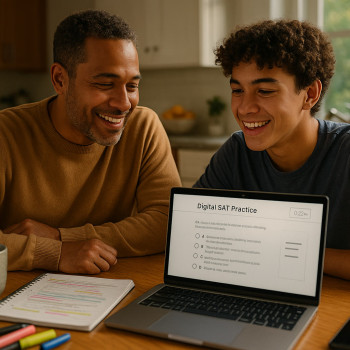Why talking about an SAT retake doesn’t have to be stressful
There’s a quiet moment many families face at the kitchen table after scores arrive: a swirl of emotions, a few questions, and sometimes a temptation to avoid the topic altogether. If your student is wondering whether to retake the Digital SAT—or if you’re a parent trying to find the right words—this guide is for you. We’ll walk through warm, pressure-free scripts you can use, explain the practical reasons students retake the SAT, and give realistic next steps and timelines so retakes feel manageable and even empowering.

Start with the right mindset: normalizing retakes
First: retaking the SAT is normal. Many students take the test more than once. The Digital SAT has changed format and delivery, which means practice, comfort with the testing app, and familiarity with shorter passages and question types can make a real difference. Instead of framing a retake as a “failure fix,” think of it as a second draft of a college-application essay: an opportunity to refine, learn, and present the best version of yourself.
Reassuring words from parents can shape how students see the retake. A relaxed, collaborative tone reduces anxiety and helps shift focus from a single number to the overall application story.
Why a pressure-free conversation matters
- Reduces avoidance: When students don’t fear judgment, they’re more likely to be honest about areas they struggle with.
- Encourages planning: Calm conversations move quickly from emotion to next steps—practice, schedule, resources.
- Protects motivation: Pressure can freeze effort. Encouragement sustains it.
Quick primer: What changed with the Digital SAT (so your script sounds informed)
Before you jump into scripting, it helps to know a few reliable facts so your conversation feels practical—not just optimistic. The Digital SAT uses a secure testing app, presents shorter reading passages tied to single questions, and often gives more time per question than older formats did. Scores are reported differently in the online student report, and many colleges continue to consider SAT scores alongside other application materials. All of this means preparation is both technical (get comfortable with the testing app) and strategic (focus on the specific content areas where practice yields gains).
Scripts: Simple conversations that feel human
Below are short, natural scripts you can adapt to your voice. Use these as a starting point for a calm and constructive conversation. Read them aloud, tweak verbs and tone, and make them yours.
1) The ‘I’m here with you’ script (for supportive check-ins)
Perfect for: a gentle follow-up after scores arrive.
“Hey — I saw your score came in. How are you feeling about it? I want you to know I’m here with you no matter what. If you want to try another time, we’ll plan it together; if you want to move on, that’s okay too. Want to walk through what felt easy and what felt frustrating so we can decide?”
2) The ‘options checklist’ script (for practical planning)
Perfect for: when the student is ready to consider next steps.
“Okay — here are the real options: we can accept this score, retake in a month or two after focused practice, or pause and revisit next season. If you’re thinking retake, which areas do you think would move most with more work? We can make a short plan and try a practice test under testing conditions first.”
3) The ‘confidence booster’ script (for anxious students)
Perfect for: students who catastrophize or feel judged by a single score.
“Scores are data, not destiny. One test doesn’t define your intelligence or your chance to get into college. We’ll use this result to make a targeted practice plan. And remember—many students improve with one focused retake, especially when they work with someone who understands the digital SAT.”
4) The ‘time-and-resources’ script (for busy families)
Perfect for: families juggling sports, classes, or jobs.
“If you decide to retake, we don’t have to overhaul your schedule. Even 3–5 focused weekly sessions can move the needle. We can map out a plan that fits with your other commitments, and if it helps, we’ll bring in tailored tutoring for the weeks before the test so study time is efficient.”
5) The ‘when parents speak’ script (to avoid pressure but offer support)
Perfect for: parents who want to be encouraging without micromanaging.
“We’re proud of all your effort. If you want to try again, we’ll support you—it could be with a study plan, a tutor for tricky areas, or some practice tests. But if you want to stop, we support that too. What do you think will help you feel confident about your application choices?”
How to listen: the quiet half of communication
Good scripts are half talk, half listening. Use open questions and give space for silence. Students often process aloud: a pause can lead to the sentence that reveals real concerns (test day nerves, worry about college fit, or confusion about superscoring). When you listen, mirror what you hear: “It sounds like you’re worried about timing,” or “I hear that the reading sections felt rushed.” That reflection helps the student feel understood and opens the door to practical next steps.
Practical next steps after the conversation
Once the emotional temperature is steady, move to action. A short, specific plan reduces anxiety and keeps momentum.
Four-step plan you can agree on in 20 minutes
- Take one official untimed practice (to review strengths and weaknesses).
- Pick a target: a clear, achievable score improvement (for example, +30–60 points in a section is realistic for many).
- Create a study rhythm: 3–5 focused sessions per week for 6–8 weeks, mixing practice tests and targeted drills.
- Decide on support: solo practice, a study buddy, or personalized tutoring for 1-on-1 guidance.
How to use a practice test to make real decisions
Practice tests are diagnostic tools—use them properly. Have your student take one official, full-length digital practice test in Bluebook or the official practice interface under simulated conditions. Time it like test day, sit in a quiet place, and avoid multitasking. Afterward, look beyond the total score. Examine which content areas missed the most points: geometry vs. algebra, sentence structure vs. reading comprehension. These insights tell you where to spend study time.
Simple table: Typical timeline and expected score gains
| Study Duration | Weekly Time | Typical Focus | Realistic Score Gain (Total) |
|---|---|---|---|
| 3–4 weeks | 4–6 hours | Targeted drills and test strategies | 10–30 points |
| 6–8 weeks | 6–8 hours | Practice tests + targeted content work | 30–70 points |
| 10–12 weeks | 8–12 hours | Deep content review + timed practice | 60–120+ points |
Note: these ranges are illustrative. Individual gains depend on starting point, consistency, and the quality of practice. Many students see the biggest returns from targeted practice and realistic test simulations.
Practical study strategies that integrate into busy lives
Not every student has hours for test prep. Here are efficient strategies that respect busy schedules and reduce burnout.
Micro-practice (15–30 minutes)
- Focus on one question type (e.g., function interpretation) and do 8–12 timed questions.
- Immediately review mistakes and write a one-sentence rule to remember.
Weekly simulated test
- Take one section under timed conditions every week, even if it’s just a reading passage or a math section.
- Rotate through sections so no area gets neglected.
Active review
- Not just re-reading notes—explain a problem out loud or teach a concept to someone else.
- Use spaced repetition for vocabulary and math formulas.
When and how to involve a tutor (and what to expect)
Personalized tutoring is especially useful when progress plateaus or when students need help translating practice gains into test-day performance. A good tutor helps with targeted content gaps, test strategies, and realistic pacing for the Digital SAT. If nerve management is an issue, tutors can also run mock test days to desensitize stressors like timed navigation in the Bluebook app.
For families considering tutoring, a smart approach is a short diagnostic period: three to six sessions focused on diagnostics, a tailored study plan, and measurable weekly goals. Sparkl’s personalized tutoring, for example, offers 1-on-1 guidance, tailored study plans, expert tutors, and AI-driven insights that can help identify the highest-impact practice for each student. When used judiciously, tutoring can compress months of progress into weeks by focusing study where it matters most.
Scripts for dealing with disappointment—and turning it into momentum
Sometimes a student decides not to retake. Other times a retake doesn’t go as hoped. How you respond matters. Here are a few grounded phrases that keep perspective and move forward constructively.
For parents: when a retake didn’t help
“I know you gave it your best. Let’s look at what improved and what didn’t. We’ll decide together whether another try is worth it or if we should focus that energy on applications, essays, and extracurriculars.”
For students: after a disappointing score
“This is a setback, not a verdict. Let’s make a short list of specific things that might change the result next time—strategy, pacing, or a few content areas—and then decide if another test is the right step.”
How colleges actually view retakes
Colleges generally see multiple SAT scores as data points. Many schools superscore (consider the highest section scores across test dates), so an improved section score can matter even if another section dipped. Admissions officers read applications holistically; a single test score is just one part of your profile. In practice, this means a well-timed, focused retake that leads to clear improvements can strengthen an application, but it’s not the only path to admission success.
Sample conversation flow you can try tonight
Try this step-by-step plan for a 20-minute, low-pressure chat.
- Open gently: “Can we talk about your SAT results? I’m curious how you feel.”
- Listen: mirror feelings without judgment.
- Ask one diagnostic question: “If you did this again, what would you want to change?”
- Offer options: three clear plans (accept, retake soon with focused plan, retake later after deeper prep).
- Agree on one small next step: take an official practice in the next 7 days, or schedule a 30-minute planning session with a tutor.
Real-world examples: brief case studies
These short sketches show how different students used calm conversations and focused plans to improve their outcomes.
Case A: The nervous senior
Situation: A senior with strong grades but an SAT score below their target felt frozen by pressure. Conversation: A parent used the “I’m here with you” script and suggested one month of targeted tutoring before a final retake. Result: Focused work on timing and a few algebra topics produced a steady 50-point total gain, and the student reported feeling more confident at interviews.
Case B: The busy athlete
Situation: A student juggling sports and school had little time for long study blocks. Conversation: The family used the “time-and-resources” script and agreed on micro-practice plus a weekly simulated section. Result: The student improved in data-heavy math questions and gained a section-level boost without sacrificing practice or sport commitments.
Final thoughts: make it manageable, not monumental
Retaking the SAT is a practical decision—one you can handle with a few calm conversations, a diagnostic test, and a short plan. Keep the focus on progress, not perfection. Celebrate the effort, and let the data guide the decisions. If you choose tutoring, make it targeted and time-bound: a clear problem, a plan, and a finish line.
Above all, remember this: your student is more than a test score. The test is a tool to communicate one part of a student’s abilities to colleges. With the right talk—and the right small steps—retakes can feel like a strategic next chapter, not a stressful redo.

Quick reference: scripts at a glance
- “I’m here with you.” — reassurance and collaborative tone.
- “Let’s make a short plan.” — practical, action-oriented.
- “Scores are data, not destiny.” — reframes the narrative.
- “What would help you feel confident?” — invites student agency.
Where to go from here
If you want a simple next move: schedule one official digital practice test under timed conditions this week. Use that test to decide whether a short, targeted program would help. If you choose outside help, consider a tutor or program that offers one-on-one guidance and a tailored study plan, so every minute of prep pushes toward the most meaningful gains. Personalized approaches—like Sparkl’s tutoring that combines expert tutors, tailored plans, and AI-driven insights—work well because they match practice to the student’s specific weaknesses and life schedule.
Take a breath. This doesn’t have to be dramatic. With a calm conversation, a bit of planning, and consistent small steps, a retake can be a confident, controlled choice—not a source of pressure.
Parting line
Be kind to each other in the process. The best prep happens in an atmosphere of trust, not fear. Say the scripts that feel true to you, listen carefully, and together make a short, achievable plan. That’s how progress—and peace of mind—happens.














No Comments
Leave a comment Cancel